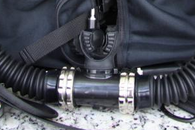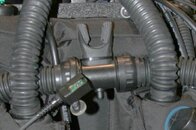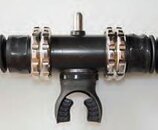Interesting theory. That would imply the DSV was installed quite literally upside down. This would indeed orient the press fit mushroom valve against the inhalation mushroom valve bisecting the loop. That would be *very* relevant as to how to do this, again, if it is even possible. BTW - Hollis marks the DSV with a label that says "Pre-Breathe" atop it from the factory which would give a cue to it's proper orientation. But, G-man seems to think her loop was from a lot of a different variant than the current production model. Either way, I can only test what I have available.
To accomplish this feat, you'd have to incorrectly install the hoses to the head, put the counterlungs on the wrong sides, the lower loop hoses would be facing the wrong way, the oxygen and diluient hoses would not fit correctly (but can be pulled or re-routed to make it work), *AND* the DSV would have to be inverted. So basically you'd have to perform nearly every step of the assembly incorrectly minus attaching the tanks and latching the scrubber bucket.
The interesting thing about assembly in this way, is that the unit should pass both the Positive and Negative tests. It also implies one other *very* relevant finding. If she built the loop this way, or was taught to do so, it eliminates the possiblity of a stereo test. This means conclusively she did not follow the checklist or build procedure. The Assembly Checklist will catch the error being blamed for her death unless you build it top-down as you suggest, because you can't perform that test.






